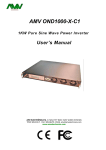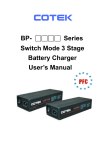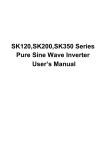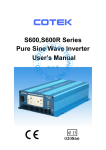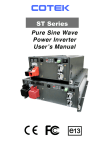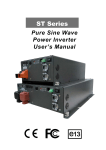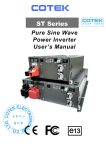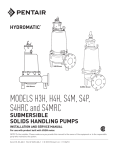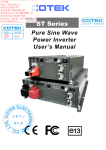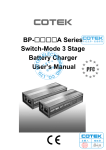Download Cotek SR Series All Models PDF file
Transcript
SR Series 1KW Pure Sine Wave Power Inverter User’s Manual Contents 1. Important Safety Instructions……………………………………………………………………. 3 1-1 General Safety Precautions…………………………………………………………………. 3 1-2 Other Safety Notes………………...…………………………………………………… 3 2. Introduction to Functional Characteristics …...……………………………………..……….. 4 2-1 System...……………………………………………………………………………………….. 4 2-2 Block Diagram.…………………..……………………………………………………………. 5 2-3 Electrical Performance…..……………………………………………………………………. 6 2-4 Mechanical Drawings………..………………………………………………………………... 7 3. Installation and Maintenance….…………………………………………………………………. 8 3-1 Rear Panel……..……………………………………………………………………………. 8 3-2 Front Panel……..……………………………………………………………………………. 14 3-3 Maintenance…….………..……….…………………………………………………………. 14 4. Operation……………………………………………………………………………………………. 14 4-1 Connecting the Input Power………………………………………………………………. 14 4-2 Connecting the loads...……………………………………………………………………….. 14 4-3 Inverter Operation...………..…………………………………………………………………. 15 4-4 Protection Features...………………………………………………………………………… 15 5 Front LCD Panel - Display and Setup...…………………………………………………. 15 5-1 LCD Panel Indications...………….……………………………….…………………………. 15 5-2 Startup Sequence and Standby Status……….……………..………………………….. 18 5-3 Setup Menu - Operation and Instructions……………………... 18 6. RS232 Communication and operation…..…………………………………………………….. 23 6-1 Operation of RS-232 Serial Port……. ………………………….…………………………. 23 6-2 Interface Commands………………………………………………..……………………….. 24 6-3 Example of RS232 Operation…………………………………………………………......... 25 7. Information………………………………………………………………………………………….. 29 7-1 Troubleshooting……………………………………………………………………………… 29 7-2 Warranty……………………………………………………………………………………... 30 1 8. Appendices………………………………………………………………………………………….. 8-1 FCC (Class B) Declaration of Conformity………………………………………………… 8-2 EMC Declaration of Conformity……………….…………………………………………... 8-3 CE (LVD EN60950) Declaration of Conformity…………………..……………………. 8-4 UL (UL458) - Notice of Completion….……………………………………………... DCopyright: This manual is the copyright of COTEK Electronic lndustrial. Co., Ltd. And may not be reproduced or copied without the express permission of the owner. 2 SR Series Inverter 1. Important Safety Instructions WARNING! SAVE THESE INSTRUCTIONS – This manual contains important instructions that should be followed during installation and maintenance of the inverter. 1-1. General Safety Precautions 1-1-1. Do not expose the inverter to rain, snow, spray or dust. To reduce the risk of fire hazard, do not cover or obstruct the ventilation openings and do not install the inverter in a zeroclearance compartment. 1-1-2. To avoid the risk of fire and electric shock, make sure that the existing wiring is in good electrical condition and that the wire size is not undersized. Do not operate the inverter with damaged or substandard wiring. 1-1-3. Depending on the use, the AC output of the inverter may require user installed breaker or fusing. For telecom use, a GFCI has not been provided. The inverter incorporates standard AC short circuit protection. 1-1-4. The following precautions should be taken when working on the inverter: ▌Remove watches, rings, or other metal objects. ▌Use tools with insulated handles. ▌Wear rubber gloves and boots. 1-2. Other Safety Notes 1-2-1. Upon receipt, examine the shipment box for damage. Notify the carrier immediately before opening, if damage is evident. 1-2-2. Do not operate near water or in excessive humidity. 1-2-3. Do not open or disassemble the inverter, warranty may be voided. 1-2-4. The DC side connections should be firm and tight 1-2-5. Grounding: Reliable grounding of rack-mounted equipment should be maintained. 1-2-6. Do not drop a metal tool on the battery. The resulting spark or shortcircuit on the battery or on the other electrical part may cause an explosion. 3 SR Series Inverter 1-2-7. Install the inverter in a well-ventilated area. Do not block the front air vents, or the rear air exhausts of the unit. 1-2-8. Wiring: Adequate input power must be supplied to the inverter for proper use; correct wiring sizes must be ensured. 1-2-9. Mount the inverter such that the fan axis is horizontal 1-2-10. Do not operate the inverter close to combustible gas or open fire. 1-2-11. Do not operate appliances that may feed power back into the Inverter. 1-2-12. Temperature: The inverter should be operated in an ambient temperature range of 0℃ to 50 ℃ or else the output efficiency may be affected. Air flow to the inverter must not be restricted 2. Functional Characteristics - Introduction 2-1. System The unit is a highly reliable DC-AC inverter system, designed with advanced power electronic and microprocessor technology offering the following features: ▌ The inverter is equipped with a self diagnosis microprocessor that is able to identify and show all failure messages on the LED/LCD display with associated visual/audio alarm(s). ▌ 1U height x 19” width x 13.6” depth, 19” rack mountable. ▌ Pure sine wave output (THD < 3%) to operate higher-end electronic equipment. ▌ Built in 12A rated transfer switch. ▌ Speeds up transfer time as a result of synchronized operation with the AC source at all times that allows the transfer to be interruption-free for sensitive equipment. ▌ Intelligent software for power management ▌ Hard-wire and Dual AC outlets connection model option. ▌ Loading and temperature controlled cooling fan. ▌ Fan aging, failure, disconnection and blockage alarm. ▌ Selectable Bypass/Inverter modes ▌ Local and remote management and control. ▌ RS-232 communication. 4 SR Series Inverter ▌ Dry contact terminal. ▌ Efficiency >90%. (Full linear load at 220 VAC Output) ▌ Advanced Protection Features: Input over/under voltage protection. Internal over temperature protection. Input reverse polarity protection (Fuse). Output overload protection. Output short circuit protection AC input short circuit protection: Breaker (6 Amp or 12 Amp) 2-2. Block Diagram AC GRID INPUT FILTER BYPASS RELAY DC INPUT AC DC DC DC AC FILTER OUTNPUT The inverter features IGBT technology which minimizes weight and dimension while enhancing output short circuit reliability and overload capacity. AC output voltage is provided in one of the two following modes: 1). From DC to AC Inverter Mode: (On-line Mode) 2). From AC Input Bypass Mode: (Off-line Mode) Either mode is front panel programmable. In the first option, Off-line mode, AC output power will be supplied through the AC bypass mode in its normal operation. Upon AC input failure, output power will be diverted through the DC to AC Inverter Mode. Once AC mains are restored, the unit will revert from the Inverter Mode to the Bypass Mode. In the second option, On-line mode, AC output power will be provided directly by the inverter from the DC source. Should the DC source or inverter fail, the system will transfer its output power through the bypass mode. Once the DC power source is restored, the system will revert to the inverter mode. 5 SR Series Inverter 2-3. Electrical Performance Electrical Input Specification Model No. Item SR1000-124 SR1000-148 SR1000-224 SR1000-248 Voltage 24 VDC 48 VDC 24 VDC 48 VDC Input Over-Voltage Protection Characteristics Input Under-Voltage Protection No Load Current 30~34 VDC (User- 60~68 VDC (User- 30~34 VDC (User- 60~68 VDC (Userselectable) selectable) selectable) 18~22 VDC (User- 36~44 VDC (User- 18~22 VDC (User- 36~44 VDC (Userselectable) selectable) selectable) selectable) 0.68 A 0.44 A 0.6 A 0.35 A Continuous Output Power 1000 W Maximum output Power (3 Min) 1150 W Surge Power 2000 W Output Frequency 50 / 60 Hz +/- 0.05 % Characteristics Output Voltage Efficiency (Full Load) selectable) 97~123 VAC(User-selectable) 87% 194~246 VAC(User-selectable) 88% 90% Short-Circuit Protection Yes , Ipk Output Waveform Pure Sine Wave (THD < 3%) LCD Panel 2 Lines LCD Panel with keypad for navigation LED Indicator Red/Orange/Green LED Dry Contact Terminal By a relay Remote Control Terminal Controls the inverter ON / OFF operation Input Protection Over/Under Voltage, Reverse Polarity (Internal Fuse) AC Output Protection Short-Circuit, Overload 91% Signal and Control Protection AC Input Protection 12 Amp Circuit Breaker 6 Amp Circuit Breaker Temperature protection Shutdown (Internal temperature≧65℃) Relay Specification 12 Amp / 250 VAC Bypass Relay On Line/Off Line (Haphazard, Normal, Exact) selectable Transfer Relay From AC bypass mode (Off-line Mode) : ≦9mS Switching Time From DC to AC inverter mode (On-line Mode):≦7mS Operating Temperature Fan Operation and Indication Mechanical Specifications Safety and EMI / EMC Full Load 0℃ ~ 50℃ Storage -30℃~70℃ Failure Indication Buzzer alarm and dry contact Switches On when: Temperature ≧55℃ or Load≧30% Switches Off When: Temperature ≦45℃ and Load≦20% Size (W X H X D) 19”x1.71”x13.6”(482.6mmX43.5mmX345mm) Weight Safety Standards 5.8 Kgs (12.7 Lbs) Meets UL60950 Meets EN60950-1 6 SR Series Inverter EN55022: 1998+A1: 2000+A2: 2003 Class B EMC Standards EN55024: 1997+A1: 2001+a2: 2003 FCC Class B EN61000-3-2: 2006 Class A EN61000-3-3: 1995+A1: 2001 Note: The specifications are subject to change without notice. 2-4. Mechanical Drawings FAILURE COM. ENB GND NEG(-) ENB INV. RS-232 CHASSIS GROUND AC OUTPUT NO REVERSE POLARITY WILL DAMAGE UNIT NC WARNING: POS(+) AC INPUT BREAKER ON OFF REMOTE SR Series Inverter Ordering Information Model Number Input Voltage Output Voltage Nominal Output Voltage Range Frequency Range SR1000-124 SR1000-224 SR1000-148 SR1000-248 24 VDC 24 VDC 48 VDC 48 VDC 110 VAC 230 VAC 110 VAC 230 VAC 100~120 VAC 200~240 VAC 100~120 VAC 200~240 VAC 47~63 Hz 47~63 Hz 47~63 Hz 47~63 Hz 7 SR Series Inverter 3. Installation and Maintenance 3-1. Rear Panel REAR PANEL VIEW AC INPUT BREAKER NEG(-) POS(+) COM. INV. NO ENB ENB REVERSE POLARITY WILL DAMAGE UNIT NC GND WARNING: FAILURE RS-232 3-1-1. AC Input Breaker: CHASSIS GROUND AC OUTPUT ↑ Correct spelling of socket The AC input circuit breaker protects the unit from overload. When an overload condition occurs, the circuit breaker trips and disconnects the AC grid power input. To reset it, push the circuit breaker button. The cause of tripping should be ascertained and corrected before the unit is reset . 3-1-2. Hard-wire Installation (AC wiring connections): ▌ AC input and AC output terminal ▌Connect AC output and AC input wiring to the Inverter terminals. Please use the following information as your reference: 8 SR Series Inverter Terminal AC OUTPUT Wire length / gauge Wire color Line (L) Black (120 VAC), Brown (230 VAC) Neutral (N) White (120 VAC), Blue (230 VAC) Line (L) Within 16 feet / AWG# 14~16 Black (120 VAC), Brown (230 VAC) AC INPUT Neutral (N) White (120 VAC), Blue (230 VAC) 26~32 feet / AWG# 12~14 Chassis Ground or FG Green / Yellow or Bare copper Note. Please double check and review all the connections to ensure that the wires are connected to the correct terminals and that the connections are tight. 3-1-3. AC output socket: 110VAC NEMA 230VAC I.E.C 60320 C13 3-1-4. Chassis Ground: Must be connected to earth ground prior to making any other connections to the equipment. 3-1-5. RS-232: Serial port for monitoring and control through computer interface 9 SR Series Inverter 3-1-6. Remote control and Dry contact terminal: RELAY NO COM. NC ENB ENB GND GROUND ENABLE - ENABLE+ ▌Remote Control Terminals: 1). Before installing the inverter, ensure that the main switch is ”OFF”. 2). Before using the remote function, ensure that the main switch is pressed towards “REMOTE”. 3). Ensure that the remote contacts are off. 4). Use 20 ~ 24 #AWG wire to connect the remote control terminals. 5). Remote control ON/OFF inverter setup status: ENB ENB ON:INV. ON OFF:INV. OFF GND TR HI:INV. LOW:INV. ON (TR ON) OFF(TR OFF) GND BAT+ BATENB ON:INV. ON OFF:INV. OFF ENB GND ON:INV. ON OFF:INV. OFF + DC - POWER NOTE: At one time, only one remote function should be used to control the inverter. The maximum voltage value is the same as input DC voltage. 10 SR Series Inverter ▌Dry Contact Terminals: Dry contact terminals may be connected to a Form C relay for “FAULT” indication. When “FAULT” occurs, the relay switches. NOTE: Fault conditions include Input under/over voltage, Output Short Circuit, Over Temperature, Over-load and Fan Failure. Specifications of the Relay Maximum Voltage 240 VAC 240 VAC 30 VDC 30 VDC Load Resistive Resistive Resistive Resistive Contact Rating N.O. N.C. 16 A 8A 16 A 8A Dry Contact Terminal COM. N.C. N.O. Number of Operating/Storage operations Temperature 100,000 -30℃~70℃ RELAY Common contact Normally closed contact. Normally open contact. 11 SR Series Inverter 3-1-7. DC Input Connection: Follow the instructions to connect the battery cables to the DC input terminals of the inverter. The cables should be as short as possible (less than 6 feet / 1.8 meters ideally) so that they can handle the required current in accordance with the Electrical Codes and Regulations. The size of the cable should be thick enough to limit the voltage drop to less than 2% when carrying the maximum input current to prevent frequent low-input voltage warnings and shutdown. UVP (Under Voltage Protection) warning may result if there is excessive voltage drop across the DC cables between the batteries and the inverter. Increasing your DC cable size will help improve the situation. Batteries are capable of providing very large currents in case of short circuit. In case there is a short circuit in the cable run between the batteries and the input terminals of the inverter, it will result in overheating / melting of the cables and consequent risk of fire and injury. To prevent possibility of this hazard, use Very Fast Acting DC Fuse in line with the positive cable. The fuse should be as close to the positive battery terminal as possible. Use Bussmann ANN series fuses ( will also require Fuse Block 4164) or equivalent The following sizes of cables and fuses are recommended for up to 6 ft. distance between the batteries and the inverter. (Applies to both 120 VAC and 230 VAC versions): Model No Wire AWG Inline Fuse SR1000-124 / 224 #4 80 A SR1000-148 / 248 #6 40 A ▌Connect DC input terminals to 24V / 48V battery or other DC power source. [ + ] is positive, [ - ] is negative. Reverse polarity connection can blow the internal fuse and may damage the inverter permanently. WARNING! Make sure that all the DC connections are tight (torque to 9 – 10 ft-lbs, 11.7 – 13 Nm). Loose connections could result in overheating and can be a potential hazard. 12 SR Series Inverter NEGATIVE- PVC WIRE RING TERMINAL (AWG#4 - #6) PVC WIRE RING TERMINAL (AWG#4 - #6) POSITIVE+ WARNING! The recommended inline fuse should be installed as close to the battery positive terminal as possible Failure use acopper fuse onwire the and “+” cable b. Also, only use highto quality keep running the cable length between the inverter and battery may cause short which is a maximum of 3 - 6 feet. damage to the cable / inverter and will void warranty. NEG ATIVE- INLINE FUSE PO SITIVE+ 13 SR Series Inverter 3-2. Front Panel FRONT PANEL VIEW ON OFF REMOTE Vi =24.0 FQ=60.0 Vo=115 Io =8.5 3-2-1. Main Switch: These are buttons for turning on, turning off and remote. 3-2-2. LED’s Indicators: See details in Section 5-1. 3-2-3. LCD Display Selection Buttons: Data pertaining to the DC input voltage, AC output voltage, AC output frequency, AC output current, etc. and system status can be shown sequentially on the LCD display by pressing these buttons. Please refer to chapter 5 for more information. 3-2-4. FAN ventilation grille (1)~(3) : The fans behind the ventilation grilles provide cooling. DOT NOT obstruct these vents! 3-3. Maintenance 3-3-1. Make sure that the fan vents are not blocked. 3-3-2. Use a vacuum cleaner to remove any dust from the fan area. 3-3-3. When cleaning the case or front panel, use a soft, dry cloth, only. If the case or front panel is very dirty, use a neutral, non-abrasive detergent. Do not use alcohol or ammonia based solutions. 3-3-4. Regular service and relocation of the inverter should be performed by a qualified service technician. 3-3-5. Avoid spilling liquid on the inverter. 4. Operation: 4-1. Connecting the input power Before making the DC input side connections, the main switch must be “OFF”. 4-2. Connecting the loads ▌Calculate the total power consumption(W) of the output load. Make sure that the total power consumption does not exceed the rated load. ▌Should the total load exceed the rated capacity of the inverter, remove the non-critical loads until the rated total has been reached. 14 SR Series Inverter 4-3. Inverter Operation ▌Set the power switch to the “ON” position. The buzzer will sound “beep beep”.The inverter will carry out self-diagnosis and the LED’s will change colors. At the same time the LCD will display ”SR-1000 INVERTER INITIALIATION..”. Finally, the buzzer will sound another “beep” and the “INVERTER” and status LED’s will turn “Green” . The LCD Display will display “Vi, Vo, FQ, Io“. The inverter will start operating normally. ▌Set the power switch to the “OFF” position. The inverter stops and all the lights that are on will go off. 4-4. Protections Features DC Input (VDC) Model Over Voltage Under Under Voltage Voltage Shut-down Restart Alarm Shut-down Restart 24 V 30.1~34.1 28~32 19~23 18.1~22.1 23~27 48 V 60.1~68.1 56~64 38~46 36.1~44.1 46~54 Over Temperature Protection INTERIOR HEAT SINK ShutShutRestart Restart down down 65℃ 45℃ 105℃ 75℃ 5. Front LCD Panel – Display & Setup 5-1. LCD Panel Indications 5-1-1. Set the Power Switch to the “ON” position. The inverter starts working normally. The inverter will be operating in normal condition when either of the following messages are displayed on the LCD screen: Vi =24.0 FQ=60.0 Vo=115 Io =8.5 15 SR Series Inverter 5-1-2. LED Indications: ▌AC GRID: Displays AC input status. AC Input LED Status AC input and DC-AC inverter output are NOT synchronous AC input and DC-AC Inverter output are synchronous AC input OFF ORANGE GREEN OFF Note. Synchronous means that the grid AC input frequency and DC-AC inverter output frequency or phase are the same (See details in Section 5-3-3). ▌INVERTER: Displays DC-AC inverter status. DC-AC Inverter LED Status Power OK GREEN Power not good RED ▌BYPASS: Displays Transfer Switch status. LED Status AC OUTPUT (LOAD) BYPASS From DC-AC inverter (On-line Mode) From AC input bypass (Off-line Mode) ▌ALARM: ORANGE OFF GREEN OFF AC INPUT DC-AC Inverter AC INPUT DC-AC Inverter Displays status of the Failure Alarm ALARM Over/Under Alarm /FAN Alarm Set alarm in the inverter to operate normally LED Status ORANGE OFF NOTE. For instructions on setting the alarm, see details in Section 5-3. 16 SR Series Inverter 5-1-3. LCD Display Selection Buttons: ▌Function of Various Keys : Function <Up>: You can use the “up” button to scroll through the menus. Function <Down>: You can use the “Down” button to scroll through the menus. Function <Page Up>: You can use the “Page Up” button to scroll through the menus. Function <Page Down>: You can use the “Page Down” button to scroll through the menus. Function <Enter Setup Menu>: Press the button longer than 2 seconds. The inverter will change to “Setup Menu Mode” which appears on the LCD screen for the user to set functions. Function <Enter>: Confirms a selection or value. 5-1-4. LCD Display: Displays inverter’s operational status. 17 SR Series Inverter 5-2. Startup Sequence and Standby Status 5-2-1. Set the power switch to “ON” to power up the inverter. The display shows “SR-1000 INVERTER INITIALIATION”, then checks the inverter. Status flow is as follows: OFF POWER SWITCH ON SR-1000 INVERTER INITIALIATION .. FAILURE CHECK INVERTER Vi =XX.X FQ=XX.X Vi =XX.X OK OR Vi =XX.X Vi =XX.X FQ=XX.X ALARM Vo=XXX Io =X.X OR Vi =XX.X OR Vi =XX.X Vo=XXX Io =X.X 1Sec 交 換顯示 Alert: Undervoltage!! OR Alert: Overload!! OR Alert: Fan Failure!! 5-3. Setup Menu - Operation and Instructions Entering Setup Menu: Press Button longer than 2 seconds. The inverter enters the Setup Menus consisting of three layers: (1)Select Menu Heading, (2)Select Menu Item (Function Code), (3) Set Value: 18 SR Series Inverter Main Menu: Select Menu: RST to default Select Item: O/P Voltage Select Item: O/P Frequency Select Item: Sync Frequency Select Item: Bypass relay Select Item: Overload Alarm O/P Frequency: 50.00Hz Sync Frequency: 7.00Hz Bypass relay: On-line Overload Alarm: 100% Select Item: UV Alarm UV Alarm: 230V Select Item: UVP Recovery UVP Recovery: 25.00V 21.00V Select Item: UVP Setting UVP Setting: 20.00V 11 12 13 14 15 Select Item: OVP Recovery 9 10 OVO Recovery: 30.00V 8 Select Item: OVP Setting 7 Select Menu: O/P Parameter OVP Setting: 32.00V 6 Select Item: Alert Setting 4 Alert , SHDN Select Item: Buzzer Setting Buzzer Setting: 3 Select Menu: I/P Parameter Alert Setting: Select Item: RS232 Baudrate RS232 Baudrate: 4800 0 MSG , Alert , SHDN Select Item: LCD Auto-off LCD Auto-off: 120S Setting Value: 2 Select Item: LCD Contrast Select Item: 1 LCD Contrast: 50% Function Code: Vo=XXX Io =X.X O/P Voltage: Select Menu: User interface Select Menu: Vi =XX.X FQ=XX.X 5-3-1. User interface (Select Menu): 0). LCD Contrast: Sets LCD screen contrast. Default=50% Setting Range= 0%~100% 1). LCD Auto-off: Sets LCD auto off timer. Default=120 seconds. Setting Range= Disable~250 seconds. 2). RS232 Baud-rate: Sets standard RS-232 Baud-rate. Default=4800 Setting Range= 1200/2400/4800/9600/19200 3). Buzzer Setting: Sets the internal buzzer sound ON/OFF. When setting, the LCD screen displays Buzzer “ON”, Buzzer “OFF”. Default=MSG, Alert, SHDN Setting Range= Disable / Shutdown / Alert / Alert, SHDN / Message / Message, SHDN / Message, Alert / MSG, Alert, SHDN 19 SR Series Inverter MENU STATUS BUZZER Message Power ON or Push Keypad ON Alert FAN Fail or UV Alarm or Overload Alarm ON Shutdown OVP or UVP or OLP or OTP ON Disable Any OFF 4). Alert Setup: When alert occurs, the internal Dry Contact Relay will MENU Alert Shutdown Disable open/close. (See details in Section 3-1-6) Default = Alert, SHDN Setting Range = Disable / Shutdown / Alert / Alert, SHDN STATUS RELAY FAN Fail or UV Alarm or Overload Alarm ON OVP or UVP or OLP or OTP ON Any OFF 5-3-2. I/P Parameter (Select Menu): 6). OVP Setting: Sets the Over Voltage Protection (OVP) and shutdown. Default = 32 VDC for 24 V Model, 64 VDC for 48 V Model Model SETTING VALUE RANGE 24 V 30 VDC ~ 34 VDC 48 V 60 VDC ~68 VDC 7). OVP Recovery: When the DC input voltage is higher than the OVP setting, the inverter shuts-down. Once the input voltage falls below the set OVP value, the inverter will automatically restart. Default = 30 VDC for 24 V Model, 60 VDC for 48 V Model Model SETTING VALUE RANGE 24 V 28 VDC ~ 32 VDC 48 V 56 VDC ~ 64 VDC 8). UVP Setting: Setting the inverter’s Under-Voltage Protection (UVP) and Shutdown. Default = 20 VDC for 24 V Model, 40 VDC for 48 V Model Model SETTING VALUE RANGE 24 V 18 VDC ~22 VDC 48 V 36 VDC ~ 44 VDC 20 SR Series Inverter 9). UVP Recovery: When the DC input voltage is below the set UVP value the inverter shuts-down. Once the input voltage rises above the set UVP value, the inverter will automatically restart. Default=25 VDC for 24 V Model, 50 VDC for 48 V Model Model SETTING VALUE RANGE 24 V 23 VDC ~ 27 VDC 48 V 46 VDC ~ 54 VDC 10). UV Alarm: Sets Under Voltage (UV) alarm. When the input voltage is lower than the set value, the unit will sound “beep” to remind that the unit is going to shutdown. At the meantime, the contact in the internal Dry Contact Relay will open / close (See details in Section 3-1-6). Default = 21 VDC for 24 V Model, 42 VDC for 48 V Model Model 24 V 48 V SETTING VALUE RANGE 19 VDC ~ 23 VDC 38 VDC ~ 46 VDC NOTE. The value of voltage set for the “UV Alarm” should be equal to or higher than the value set for “UVP” or else the unit will shutdown without any audible warning. 5-3-3. O/P Parameters: 11). O/P Voltage: Sets the inverter output voltage. Default = 110 VAC for 110 V Model, 230 VAC for 220 V Model Model SETTING VALUE RANGE 110 V 97 VAC ~ 123 VAC 220 V 194 VAC ~ 246 VAC 12). O/P Frequency: Sets the inverter output frequency. Default = 60Hz for 110 V Model, 50Hz for 220 V Model. Model SETTING VALUE RANGE 110 V 47 Hz ~ 63 Hz 220 V 47 Hz ~ 63 Hz 13). Sync Frequency: Sets the AC output synchronous frequency. Example: DC to AC inverter = 230 VAC / 50Hz User setting Value = 7Hz When the AC input (GRID) “Frequency” is within the range of 43 Hz~57 Hz, the internal transfer relay will 21 SR Series Inverter Model 110 V 230 V operate normally . When the “Frequency” of the incoming grid power is less than 43 Hz. or more than 58 Hz., the internal transfer relay will de-energize (See details in Section 2-2) Default = 0.1Hz ~ 7Hz. SETTING VALUE RANGE 0.1 Hz ~7 Hz 0.1 Hz ~ 7 Hz 14). Bypass Relay: The setup is provided in one of the following two ways: On line Mode or Off Line Mode ( Exact, Normal, Haphazard) Default = Normal (Off line). MODE MENU Transfer Relay Switching Feature The transfer relay will switch “ON” or “OFF” based on Exact conformance to the Sync Frequency window that has been set (Function Code 13) The transfer relay will be “ON” if AC input (Grid) power is Normal available. The DC-AC inverter OFF LINE will remain synchronized with (See details in Section 5-3) the incoming AC power (Grid). The relay will NOT switch off if the grid frequency is beyond the range set under Sync Frequency window (Function Code 13) The transfer relay will switch Haphazard “ON” or “OFF”. Conformance to phase and frequency synchronization will not be considered ON LINE --------(See details in Section 5-3) 22 SR Series Inverter Frequency Synchronous Phase Synchronous F Phase DC-AC inverter DC-AC inverter F Phase AC input (GRID) AC input (GRID) 15). Overload Alarm: Sets the overload alarm. When the output power is higher than the set value, the unit will sound “beep” to remind that the unit is going to shutdown. At the same time, the internal Dry Contact Relay will open/close (See details in Section 3-1-6). Default = 100% Setting range = 50%~110% 6. RS-232 Communication and Operation 6-1. Operation of RS-232 Serial Port: 6-1-1. This unit uses a standard 9-Pole D connector and three of the RS232 signal lines: 1 2 6 Signal description N.C RXD TXD DTR GND DSR RTS CTS N.C 3 7 4 8 5 9 PIN 1 2 3 4 5 6 7 8 9 23 SR Series Inverter 6-1-2. The connection between this unit and the computer is as follows: RXD TXD GND DTR DSR RTS RXD TXD GND 6-1-3. The RS232 interface of this unit employs ASCII code to implement the asynchronous serial transmission control. The byte structure is START-BIP – 8 BIT DATA-STOP BIT. Baud rate: 1200/2400/4800/9600/19200 (See details in Section 5-3-1). 6-1-4. Coupled with PC software application port. Operation is as detailed in Section 6-2. 6-2. Interface Commands: The buffer size used for the RS232 port is 12-byte. This unit will ignore all bytes more than this value. During transmission, this unit will indicate it is ready to receive data from computer by this DTR line. A computer has to check the DTR line before sending any information to this unit. This unit is normally always ready to receive data while operating. When a LF character (ASCII code 0AH) is received, this unit would finish the receiving by clearing the DTR status and begin to interpret the received information. The unit would execute the received command (AND/OR data) if it is correct. Irrespective of whether the command is accepted or not, the unit will always send back a response signal to the computer and set DTR to ready for receiving more incoming information. 6-2-1. The Baud-rate of the RS232 interface can be set with the help of the Setup Menu (See details in Section 5-3-1). Note. You have to reset the unit after adjustment to activate the new setting. 24 SR Series Inverter 6-3. Example of the RS232 Operation: 6-3-1. RS232 command: Command format: This unit uses high-level language commands with a CR (0DH) and LF (0AH) as the end of the command. The system would interpret and execute the command only after these two characters are received. After the unit execute the command, it would send a response string to the computer. The response string is as follows: = > CR LF: Command executed successfully ? > CR LF: Command error, not accepted ! > CR LF: Command correct but execution error (e.g. parameters out of range). If the command needs any information from the unit, the unit would send the information back to the computer (with CR and LF) and then send the response string to the computer. 6-3-2. Command format: This unit supports the following command format. There should always be a CR (0DH) and a LF (0AH) appended to the command while sending the command to this unit. 1). Command to switch the Power ON/OFF: Format: Power <value> Example: A space (ASCII code 20H) is needed between Power and <value>. <value> can be one of the following. “0”: Power off “1”: Power on 2). Command to query the Output Frequency: Format: FRQ? After “Enter”, the unit’s “Output Frequency” appears on the PC screen. 3). Command to query the Output Voltage Format: VOL? After “Enter”, the unit’s “Output Voltage” appears on the PC screen. 25 SR Series Inverter 4). Command to query the Output Current Format: AMP? After “Enter”, the unit’s “Output Current” appears on the PC screen. 5). Command to query the Input Battery Voltage: Format: BAT? After “Enter”, the unit’s “Input Voltage” appears on the PC screen. 6-3-3. Command for accessing Setup Menus and adjusting values: 1). Selecting the Setup Menus with the help of Function Codes: Format: FUNC <Function Code> After “Enter”, the Setup Menu for the Function Code will be called. The <Function Code> = 0~17, as follows: <Function Code> Setup Menu <Function Code> 0 LCD Contrast 9 1 LCD Auto-off 10 2 RS232 Baud-rate 11 3 Buzzer Setting 12 4 Alert Setting 13 5 NOT USED 14 6 OVP Setting 15 7 OVP Recovery 16 8 UVP Setting 17 Setup Menu UVP Recovery UV Alarm O/P Voltage O/P Frequency Sync Frequency Bypass Relay Overload Alarm NOT USED NOT USED 2). Command to query the Functions No: Format: FUNC? After “Enter”, the unit’s “Function Code” appears on the PC screen. 3). Command to query the set value of the Function: Format: SETT? After “Enter”, the existing set value of the function appears on the PC screen. 4). Command to set or adjust the value of the Function: Format: SETT <value> After “Enter”, the new value of the Function is set Choose the <value> of the function as follows: FUNC 0: LCD Contrast Setup Menu SETT <value> LCD Contrast 0~100 26 SR Series Inverter FUNC 1: LCD Auto-off Setup Menu SETT <value> LCD Auto-off Disable~250 FUNC 2: RS232 Baud rate Setup Menu SETT <value> Baud rate 0 1200 1 2400 RS-232 Baud 2 4800 rate 3 9600 4 19200 FUNC 3: Buzzer Setting Setup Menu SETT <value> Buzzer (Beep sound) 0 Disable 1 Shutdown 2 Alert 3 Alert , SHDN Buzzer Setting 4 Message 5 Message , SHDN 6 Message , Alert 7 Msg , Alert , SHDN FUNC 4: Alert Setting Setup Menu SETT <value> 0 1 Alert Setting 2 3 FUNC 6: OVP Setting Setup Menu SETT <value> OVP Setting 30~34 60~68 Alert Disable Shutdown Alert Alert , SHDW Model SR1000-124 SR1000-224 SR1000-148 SR1000-248 27 SR Series Inverter FUNC 7: OVP Recovery Setup Menu SETT <value> Model SR1000-124 28~32 SR1000-224 OVP Recovery SR1000-148 56~64 SR1000-248 FUNC 8: UVP Setting Setup Menu SETT <value> UVP Setting 18~22 36~44 FUNC 9: UVP Recovery Setup Menu SETT <value> UVP Recovery 23~27 46~54 FUNC 10: UV Alarm Setup Menu SETT <value> UV Alert 19~23 38~46 FUNC 11: O/P Voltage Setup Menu SETT <value> O/P Voltage 97~123 194~246 Model SR1000-124 SR1000-224 SR1000-148 SR1000-248 Model SR1000-124 SR1000-224 SR1000-148 SR1000-248 Model SR1000-124 SR1000-224 SR1000-148 SR1000-248 Model SR1000-124 SR1000-148 SR1000-224 SR1000-248 FUNC 12: O/P Frequency Setup Menu SETT <value> O/P Frequency 47~63 FUNC 13: Sync Frequency Setup Menu SETT <value> Sync Frequency 0.1~7 28 SR Series Inverter FUNC 14: Bypass Relay Setup Menu SETT <value> MODE 0 ON LINE 1 Haphazard(OFF LINE) Bypass Relay 2 Normal(OFF LINE) 3 Exact(OFF LINE) FUNC 15: Overload Alarm Setup Menu SETT <value> Overload Alarm 50~110 7. Information 7-1. Troubleshooting WARNING Do not open or disassemble the SR series Inverter. Attempting to service the unit may cause risk of electrical shock or fire. Problems and Symptoms Possible Cause No AC Power “Output” a. LCD Panel Display “OLP Shutdown”. Short circuit ,wiring error . over loading. b. LCD Panel Display “OVP Shutdown” Over input voltage (OVP) c. LCD Panel Display “UVP Shutdown” Low input voltage. (UVP) d. LCD Panel Display “OTP shutdown” Thermal shutdown. (OTP) Solutions Check AC wiring for short circuit . Reduce load. Check input voltage Reduce input voltage Recharge battery. Check connections and cables. Improve ventilation. Make sure ventilation grilles / slots of the inverter are not obstructed. Lower ambient temperature. 29 7-2. Warranty We guarantee this product against defects in materials and workmanship for a period of 24 months from the date of purchase and will repair or replace any defective power inverters if you directly returned them to us with postage paid. Please note that Cotek is only responsible for ensuring our products are operational before delivering. This warranty will be considered void if the unit has been misused, altered, or accidentally damaged. Cotek is not liable for anything that occurs as a result of the user’s fault. 8. Appendices 30 No. 33, Rong Hsin Rd., Pa Teh City, Tao Yuan County, Taiwan Phone:886-3-3661581 FAX:886-3-3676029 E-mail:[email protected] http:// www.cotek.com.tw 2007.05 31
































